Earlier I have mentioned in the second chapter that there existed three different ideas about nationalism in Sindh during the period of Shah Latif. They were the following:
Addressing the Hindus, he says:
He always considered their differences senseless and deceptive, the truth about which was beyond the comprehension of intellectually blind. Shah Latif says:
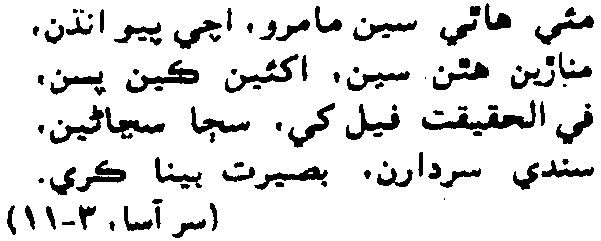
In their opinion, the religious disputes mean no more than the blind groping in the dark, or the dogs fighting over a bone. They always profess a faith in this manner:

The following verse appears to expound his central thought about religion:

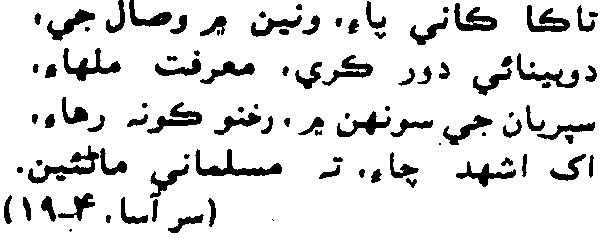


When Shah Latif prayed for the fertility of the homeland and the prosperity of his people, he prayed for the whole nation, without having any thought of discrimination based on religion and faith.
It was due to these reasons that he could not accept the idea of a separate nationality of the Muslims, which was based on the philosophy of deism. He says:

He could never visualize that humanity, creation of one God, living like neighbors and people belonging to the same country, could be considered as a separate nation on the basis of a few customs, traditions and beliefs, although they believe in one and the same God following their different modes of worship. He expresses himself reflecting this truth in a beautiful manner in this verse:
Because Shah Latif held such views about religion, he saw no difference between friend and foe. Censuring the weakness and defects of Muslim (Mullahs) and Hindu (Pundits) priests, who desired to create hatred and enmity between human beings in the name of religion, he says:
In the same manner, sometime in a state of ecstasy, he addresses the fanatic sectarian elements:

He knew fully well that it is quite easy to be called a Muslim, but to be really elevated to the position of perfection requires suffering and self-sacrifice. Even the prophets and the saints prayed that their life in this world might end as Muslims. However, if the present state of Muslims is viewed, Islam is confined to the Holy Qur'an and the Muslims have lost their faith. However, for Shah Latif religion signified love and affection for others and most of the Muslims had lost its awareness. Referring to this painful situation, he says:
Shah Latif was deeply grieved and pained to see to which low level the Muslim priests (Mullah) had brought the religion. He could observe how human beings had been split into groups of sectarian antagonism in the name of God, and the entire society had become diseased as a consequence of this fallacious and poisonous teaching. Being disgusted at this deplorable state of society, he expresses himself in the following manner:
He possessed a complete knowledge about the incidents of the history of the Muslims. There were no limits to which Mullahs would not go in the name of Shariah and Islam. Crucifying Mansur, having Shams Tabrez flayed, having Makhdoom Bilawal crushed in the oil-expeller, hanging Sarmad on the cross, and having Shah Inayat assassinated, were those incidents, which were well-known to him. All those people were responsible for these tragic events, who claimed to disseminate the Islamic Law, and whose entire history was replete with the deeds of darkness.
These tragedies only served to prove an impediment in the propagation of Islam. The prejudiced and narrow-minded attitude of Mullahs (priests) only confined Islam, a religion befitting human nature, to merely beliefs, forms of worship, customs and a social attitude. When Shah Latif observed that the adulterers, drunkards, oppressors, usurpers and the unscrupulous exploiters of the needy and the destitute, and the men leading a life of Luxury had become the representatives of a nation, who claimed to serve as a pattern to be followed by the world, he found it absolutely impossible to accept this situation and was constrained to say.

The Idea of a United India
Although this problem originated the philosophy of pantheism and harmonized with Shah Latif’s school of mysticism as well, but Shah Latif’s far sightlessness had perceived that in the vast subcontinent of India lived the people with different faiths, social standards, languages, races and cultures, and uniting it into one nation through an artificial plan and program was a principle which appeared to be very good and attractive, but practically for a long time to come it was impossible for it to be fruitful. It was on this account that rather than an Indian united nationality he found it much easier and more practicable to espoused the idea of Sindhi nationality. He found himself still more firmly convinced of his view due to the facts stated below:
A. Due to the unbiased influence of Buddhism since the ancient times, the teachings of Guru Nanak, the preaching of Hindu saints and pious men and the non-sectarian and tolerant teaching of Muslim mystics, the Hindus living in Sindh were free from religious fundamentalism and narrow-mindedness as compared to the Hindus living in other provinces and were closer to the Muslims in their way of life.
B. The Muslims were influenced by the mystics, the fundamental principle of whose teachings was love. Moreover on the one hand having no contact with the fanatic and narrow-minded Hindus, being the majority, and on the other hand having ruled for a long period of time they were unbiased and were firm advocates of religious tolerance.
C. A small country, one language, common traditions, abundance of food, people generous and patriotic, loving, dignified and courteous: these were the virtues which were most suitable for making the people a nation without discrimination of religion and faith.
It appears that before arriving at these conclusions Shah Latif had conducted a close and deep analysis of the conditions after travelling through most of the regions of Sindh. He observed that especially the people of two different races lived in Sindh: one the Aryan race and the other Smat (Semitic race), and he found some distinguishing characteristics in these two races. He considered Baluchis as Aryans, and Samoos, Soomras and other native people belonging to the Smat (the Semitic race). Some of the tribes Shah Latif has especially mentioned in his poetry are the following:
Baluch: Sometime they have been called by the names of Aryans, Keechi, Jut and sometime Areecha. These people had migrated from Makran, Kalat, Muzaffar Garh and Dera Ghazi Khan.
Smat: This word is a combination of Samma and Soomro. The tribes of Abro, Dasro, Jareja, Lakha Rahoo, Unar, and Jakhra are the offshoots of this tribe. They were the natives of central Sindh, Kachh and Kathiawar.
The Common People: Shah Latif called these people by the names of Maroo, Sanghaar, Warehja Panhwar, Vanjara (nomads) Mallah (Batmen), Mangta (beggars), Bhaan (Jugglers) Sodha, Dhai, Rebara, Kachhi, Odh, Mahana and Mehar.
Shah Latif had developed a special attachment with the Baluchi tribe. He had closely observed their virtues of courage, determination adherence to their pledge and the qualities of leadership. They were completely fed up with the arrogant and fascist government of Kalhora and their hypocritical policies. So he was beginning to see the signs of a change in Sindh through the Baluchis and was determined to develop self-confidence in them and give them encouragement. All the fine tunes of the poetry of Shah Latif are replete with the praise of the tales and characters of Baluchis. Some of the lines of his verse have become proverbial in the praise of the Baluchis:
At one place making an evident suggestive comments about the quality of political leadership of Baluchis, he says:
These hopes and predictions of Shah Latif were soon fulfilled. The reign of Kalhoras came to an end and the Baluchis assumed the reigns of power. He has given utterance to his old attachment with the Baluchis in the following manner:
He experienced extraordinary joy whenever he maintained his contact with or associated with Baluchis:
At one place he blesses and prays most sincerely for the Baluchis in these words:
At another place, he expresses himself about their value and martial qualities in following words:
To be a Baluch, in other words to be a man bearing those characteristic qualities most pleasing to Shah Latif, is not within the reach of every person. In order to develop these qualities a man requires the courage to live a life of honor rather a life of dishonor and degradation. One has to develop the sentiments of personal dignity and national pride, to remain firm and determined against any temptation, and to adopt the course of independence and truth. As in the Baluch nation, Shah Latif also observed some similar distinctive virtues in the Smat tribes, such as trustworthiness charity, generosity and adherence to the traditional values and to protect those who seek refuge. Identifying these virtues Shah Latif says:

Shah Latif regarded Smat as a monument to Sindhi culture and civilization, but had also come to realize that since a long time, as a result of remaining in power and living a life of luxury and pleasure, they had lost the qualities of a evolutionary character and martial spirit.
The section of the society, which Shah Latif has praised most, is the section of the poor society of Sindh, in which are included Sindhi farmers, sheep rearing nomads, Doothi deserts dwellers (who mostly subsist on the seeds of a variety of grass), fishermen the people using blankets and sheets woven by themselves, semi-naked poor and the wretched people who made their home in the jungles and deserts. It was among these people that Shah Latif discovered the reflection of real spirit of Sindhi and expressed a deep sense of grief and shed tears over their poverty, homelessness, ruin, ignorance and suffering. He considered the people of Sindh and their future prosperity related to each other, and considered pains and suffering a calamity for Sindh. In the same manner, he considered their liberties and progress, a secret of the welfare and honor of Sindh. Every nation has a role to play in the reconstruction and rebuilding of the world and in his opinion. The Sindhis have to play their role in this connection, and this objective can be achieved only when Sindhis struggle to elevate to the highest level, their oldest civilization, which they have inherited through the experience of centuries. He was thoroughly aware of the fact that the Sindhis were much more backward as compared to other nations. The society consisted mostly of a nomadic way of life, and the level of national production was great deal lower as a compared to other nations. However, inspite of this backwardness he always made an effort to protect them against an inferiority complex as a nation, by encouraging them to feel a sense of pride about the little they possessed. He fully understood that until and unless the nation developed an element of national honor and dignity, they would not be able to develop self-confidence, and would fail to convey their message to the world and Sindhis will continue be slaves of others politically, economically and intellectually.
Shah Latif has highlighted this theme in detail in "Sur Maivi". In this, he has used the metaphor of Maroo describing the people of Sindh. He has compared the rule of foreigners with the prison of Umer Kot, has called the ruling class by the name of Umer Soomro, and has compared the independence of the people with the life of picking desert flowers in Malir. In the same manner he has called the true representatives of the Sindhi people and the patriotic members of society who understand the real value and worth of freedom, and really have a sympathy for the backward people, by the name of Marvi. Shah Latif had a good reason for his conviction that Sindhis, despite their being the victims of backwardness, are superior to other nations of the world. He possessed a complete knowledge and consciousness of economic backwardness, but rather than considering it as a fault; he describes it as a reality of their situation. He says:

Describing their garments Shah Latif says:

He draws the picture of their general condition in the following manner:
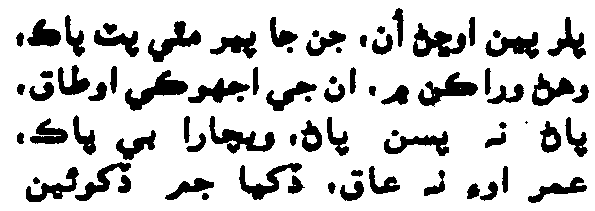
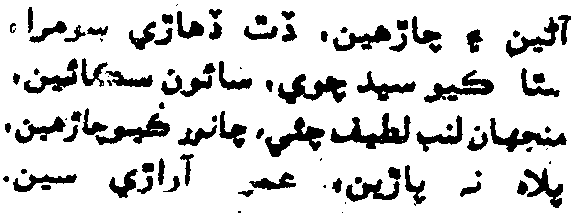

In the same manner expressing his deeply felt sentiments about desert dweller, Werejhas and Panhwares, the people of Sindh, who suffer at the hands of others because of their poverty, who labor days and nights in the service of others, he speaks in the following manner:
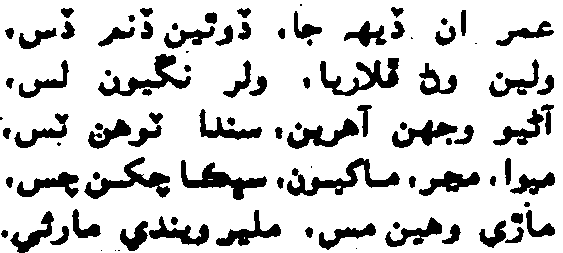
Then he says:


Shah Latif is not impressed by the splendor, awe and the authority of the ruling class, rather he feels proud of the nomadic civilization of the people of Sindh. Thus comparing them, he expresses his sentiments in the following verses:

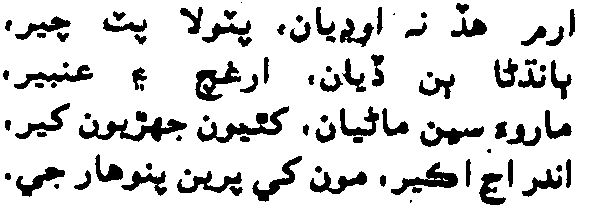


Shah Latif has given the people of Sindh the message of freedom from the slavery of the rulers, snapping of chains, destruction of the oppressive rule, and the ultimate triumph of the people’s revolution. He has counseled people to be loyal and determined and those who are suffering now; he has consoled and comforted them by predicting a happy future. Giving them strength and courage, he says:




Without discrimination of Hindus and Muslims, Shah Latif has regarded all the people of Sindh as Sindhis. In his poetry, the characters he has praised were mostly Hindus. Notable among them were Hindu Raja Diach, Lakhu Phulani, the Hindu Chief of Sindh, Rana Sodha, the Rajput of Thar, Momal, who was a Hindu Rani and Sassi who also belonged to the Hindu community. Besides these heroes and heroines, he mentions in his poetry Odh, Jareja, Rebara or Rebari, Jogi, Babu, Sanyasi and Aadesi, all of whom, were Hindus. Shah Latif has showered praises neither on Muhammad bin Qasim nor Mahmud Ghaznvi. Rather the reader will find nowhere in his poetry the mention of these conquerors or conquerors like them. If the religious governments of Aurangzeb or Kalhoras had influenced him, at least he would have made their names part of his poetry, but there is hardly any mention of either of these two. He has, no doubt, praised the Baluchis but it was mainly due to the fact, that the Baluchis wrested power from the hands of Ka1horas, and in the place of their government based on religious fanaticism, they established religiously tolerant government. Now here in his poetry does Shah Latif make a Maulvi or Mullah as the subject of praise. On the other hand, he has shed tears remembering the pilgrims to Hinglaj, the bathers in Ganges and those who blow their horn as a form of worship.